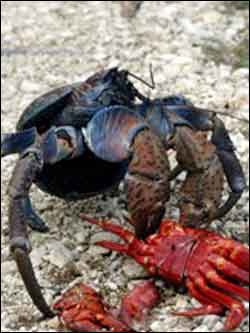It came from the sea: ’Monster’ crabs evolve a bug’s nose

New results show that land-living crabs, descended from marine ancestors, have re-invented key aspects of the insect nose through evolution in order to solve the problem of olfaction in their air-filled terrestrial environment.
The robber crab, Birgus latro, is the world’s largest land-dwelling arthropod, with a weight reaching 4 kg and a length of more than half a meter. Robber crabs are perhaps most famous for their ability to climb tall palm trees in search of coconuts, which they later are able to crack open with their massive claws. These crabs are fully adapted to a life on land and will actually drown if submerged in water. The robber crab’s transition from sea to land has been accomplished through numerous, and in many cases far-reaching, adaptations. A question not previously addressed is how the robber crabs have adapted to olfaction in their new environment – an intriguing question because the sense of smell needs to operate under very different conditions in air compared to water.
In the new work, Marcus Stensmyr and Bill S. Hansson from the Swedish University of Agricultural Sciences, together with colleagues from Lund University, Sweden and the University of New South Wales, Australia, show not only that these impressive crabs have a functional sense of smell but that the olfactory system they have developed is in fact highly sophisticated and sensitive. Moreover, the crabs have managed this evolutionary feat by adopting olfactory strategies similar to those of insects.
Remarkably, the similarities between the crab and insect olfactory systems extend to functional, behavioral, and structural characteristics. The “insect nose” of the robber crab is a striking example of convergent evolution and nicely illustrates how similar needs of very distantly related organisms may cause similar end results.
Media Contact
All latest news from the category: Life Sciences and Chemistry
Articles and reports from the Life Sciences and chemistry area deal with applied and basic research into modern biology, chemistry and human medicine.
Valuable information can be found on a range of life sciences fields including bacteriology, biochemistry, bionics, bioinformatics, biophysics, biotechnology, genetics, geobotany, human biology, marine biology, microbiology, molecular biology, cellular biology, zoology, bioinorganic chemistry, microchemistry and environmental chemistry.
Newest articles

Cost-effective, high-capacity, and cyclable lithium-ion battery cathodes
Charge-recharge cycling of lithium-superrich iron oxide, a cost-effective and high-capacity cathode for new-generation lithium-ion batteries, can be greatly improved by doping with readily available mineral elements. The energy capacity and…

New regulator of eating behaviour identified
The rapidly escalating prevalence of overweight and obesity poses a significant medical challenge worldwide. In addition to people’s changing lifestyles, genetic factors also play a key role in the development…

Harnessing Machine Learning for Breakthroughs with High-Power Lasers
A team of international scientists from Lawrence Livermore National Laboratory (LLNL), Fraunhofer Institute for Laser Technology ILT, and the Extreme Light Infrastructure (ELI) collaborated on an experiment to optimise high-intensity…





















